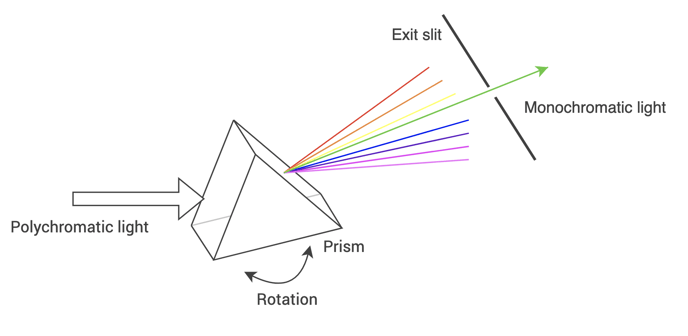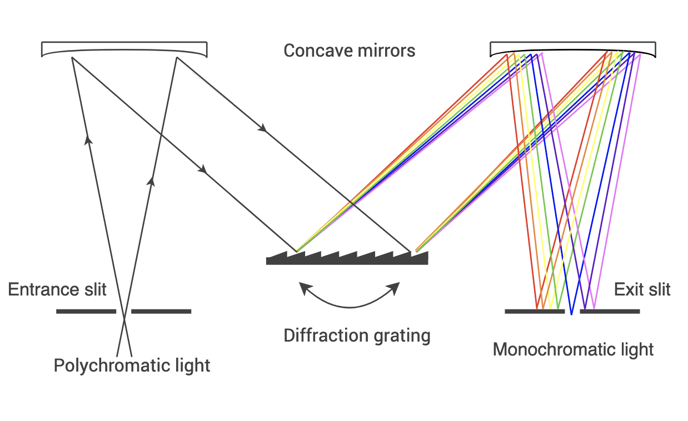What is a monochromator in a UV-Vis spectrophotometer?
A monochromator is an important part of a UV-Vis spectrophotometer. Here you can learn more.
Please note that there are two main types of UV-Vis spectrophotometers: monochromator-based instruments and diode-array instruments. There is no monochromator in a diode-array instrument. Learn more here.
A monochromator is an optical apparatus that can be found inside traditional spectrophotometers. The monochromator contains an entrance slit, a dispersive element (usually a diffraction gratin or a prism) and an exit slit. Typically the widths of the entrance and exit slits are fixed for a given instrument. A source of light passed through the entrance slit and splits into distinct wavelengths. Depending on the spatial position of the dispersive element, a fraction of this light containing a small band of light at a defined wavelength range will be transmitted through the exit slit. The output light is often referred to as monochromatic light, but in practice will usually contain a narrow wavelength range. The monochromator is usually placed between the light source and the sample.
Diagrams of Monochromator Set-ups

Fig. 1 A diagram depicting part of a monochromator set up using a prism as the dispersive element. Prisms were used in early spectrophotometers and have since been replaced by diffraction gratings. The full monochromator set-up necessarily includes an entrance slit and some arrangement of lenses or mirrors.
 Fig. 2 A simplified diagram of one of the first diffraction grating based monochromator set-ups, known as the Czerny-Turner monochromator. By rotating the diffraction grating and creating an asymmetrical geometry, a very narrow range of wavelengths can be isolated.
Fig. 2 A simplified diagram of one of the first diffraction grating based monochromator set-ups, known as the Czerny-Turner monochromator. By rotating the diffraction grating and creating an asymmetrical geometry, a very narrow range of wavelengths can be isolated.
Relation to Spectral Resolution
The width of the entrance and exit slits in the monochromator is one factor that directly impacts the spectral resolution of an instrument. A narrower slit improves the spectral resolution, whereas a wider slit reduces it. However, a narrower slit width will also reduce the amount of light reaching the detector per unit of time. This can result in longer measurement times and crucially, an increased signal-to-noise ratio. Depending on your experiment, you may prioritise reduced noise in your data over the ability to finely distinguish between peaks.
Diode-Array Based Instruments
In contrast, there is no monochromator inside a diode-array instrument. However, a very similar set-up is implemented where there is no exit slit, but the entry slit is imaged onto the sensor array directly. Reference 5 includes a diagram of an example set-up in a diode-array spectrophotometer where the similarities between the monochromator-based instrument are clear.
Interested in how you can upgrade your existing UV-Vis spectrophotometers and easily streamline and automate your data analysis? Learn more here.
References:
1. https://en.wikipedia.org/wiki/Monochromator
3. https://www.nireos.com/how-does-a-monochromator-work/